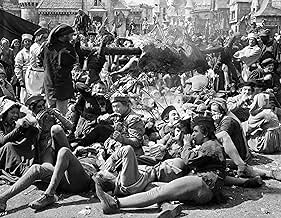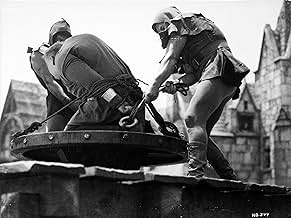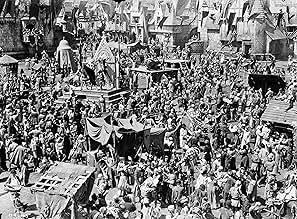IMDb रेटिंग
7.8/10
13 हज़ार
आपकी रेटिंग
अपनी भाषा में प्लॉट जोड़ेंIn 15th-century France, a gypsy girl is framed for murder by the infatuated Chief Justice, and only the deformed bellringer of Notre Dame Cathedral can save her.In 15th-century France, a gypsy girl is framed for murder by the infatuated Chief Justice, and only the deformed bellringer of Notre Dame Cathedral can save her.In 15th-century France, a gypsy girl is framed for murder by the infatuated Chief Justice, and only the deformed bellringer of Notre Dame Cathedral can save her.
- निर्देशक
- लेखक
- स्टार
- 2 ऑस्कर के लिए नामांकित
- 1 जीत और कुल 2 नामांकन
Cedric Hardwicke
- Frollo
- (as Sir Cedric Hardwicke)
Helene Reynolds
- Fleur de Lys
- (as Helene Whitney)
Minna Gombell
- Queen of Beggars
- (as Mina Gombell)
Rod La Rocque
- Phillippe
- (as Rod LaRocque)
फ़ीचर्ड समीक्षाएं
The 1939 version of Hugo's classic tale of beauty and the beast is definitely the definitive. It features a great performance by Charles Laughton as Quasimodo, dubbed the Hunchback of Notre Dame, because of his twisted appearance. It's pointless for me to talk about the story, because I'm sure everyone is familiar with it, it's one of the best works of literature ever produced. Id' just like to say this is a beautiful film about a beautiful person, cursed to be considered an out cast, "the king of fools"... Films like this and David Lynch's The Elephant Man really make you think a little differently about this so-called "beautiful" world. The Hunchback of Notre Dame has something for everyone to enjoy.
Losy in the monatge of 1939 films ...somewhat is a film I believe is more enriching and florid than " Gone With The Wind" and possibly just as romantic as " Wuthering Heights"
Laughton's performance is one of the most astonishing put on film ever. A Stellar cast is in place from O' Hara to O' Brien..What can I say , Thomas Mitchell who probably graced more films than any other actor is superb.
Hugo,s timeless classic is brought to life in black and white and with sets that make you feel ..you are there.
The great Cedric Hardwicke potrays the tormented one and for sure ..its 116 minutes of pure film making ..and it all takes place on fools day....
CP
Laughton's performance is one of the most astonishing put on film ever. A Stellar cast is in place from O' Hara to O' Brien..What can I say , Thomas Mitchell who probably graced more films than any other actor is superb.
Hugo,s timeless classic is brought to life in black and white and with sets that make you feel ..you are there.
The great Cedric Hardwicke potrays the tormented one and for sure ..its 116 minutes of pure film making ..and it all takes place on fools day....
CP
One of the great Hollywood films of 1939, this adaptation of Victor Hugo's novel is sumptuously put together, boasting a fine script, tight direction by German export William Dieterle, and a cast who fit their parts perfectly: Charles Laughton superb as the maligned Quasimodo; Maureen O'Hara in an early role as gypsy Esmeralda; Cedric Hardwicke as the pious Frollo; and Harry Davenport as the king, Louis XI.
The story is a version of Beauty and the Beast set within the confines of Notre Dame Cathedral and the dirt-strewn and prejudiced streets of Paris. Quasimodo, physically repulsive and deafened by the bells of the cathedral, nevertheless finds it in his childish heart to love the beautiful Esmeralda and to sacrifice his sanctuary for her. She however only has eyes for the dashing Gringoire (Edmond O'Brien) who she saves from the justice of the beggar thieves.
It is Laughton's performance that holds this film together - truly one of the greatest screen actors, capable of portraying pathos like no other. Contrast this film role with his Henry VIII or Captain Bligh and you begin to get an idea of his impressive range.
The story is a version of Beauty and the Beast set within the confines of Notre Dame Cathedral and the dirt-strewn and prejudiced streets of Paris. Quasimodo, physically repulsive and deafened by the bells of the cathedral, nevertheless finds it in his childish heart to love the beautiful Esmeralda and to sacrifice his sanctuary for her. She however only has eyes for the dashing Gringoire (Edmond O'Brien) who she saves from the justice of the beggar thieves.
It is Laughton's performance that holds this film together - truly one of the greatest screen actors, capable of portraying pathos like no other. Contrast this film role with his Henry VIII or Captain Bligh and you begin to get an idea of his impressive range.
Though the French have done many versions of Victor Hugo's celebrated classic, this version starring Charles Laughton has certainly stood the test of time and is the best known and loved in the English speaking world.
Lon Chaney, Sr. did an acclaimed silent version of The Hunchback of Notre Dame and Laughton was following a great tradition. And he did it in the manner of Chaney, almost without dialog. Not that Hugo wrote too much dialog for Quasimodo in his story, but except for his time with Esmerelda in the tower after he rescues her, Laughton is almost speechless in the film. Of course his character in addition to being deformed is also deaf from the ringing of those cathedral bells.
Quasimodo born deformed as he was, was left as an orphan on the steps of the Notre Dame cathedral in medieval Paris. Raised in the sheltered atmosphere of the church, he derives some joy in his duties as the bell ringer in the tower. His mentor is the brother of the archbishop played by Cedric Hardwicke and the archbishop is Walter Hampden. Quasimodo's life is useful, but without love.
But Laughton is crushing out on Esmerelda the gypsy girl played by Maureen O'Hara in her American screen debut. Problem is that Hardwicke is also getting hot and bothered by her.
Hardwicke's role is the second best acted in the film next to Laughton's. He's a man with shall we say some issues. He's purportedly committed to the church and it's celibacy requirements. But Dr. Freud wasn't around back in the day of Louis XI to tell us about sex drives. Hardwicke's desires mean only one thing, Esmerelda has to have bewitched him. When he kills Alan Marshal who is also interested in Maureen and looks like he's about to round third so to speak, the blame goes on Maureen.
What I like about the story is how the lives of two very ordinary people, Quasimodo and Esmerelda, become the focal point for a whole lot of religious and political issues of the day. The church, the peasants, the just developing middle class, and the nobility all have an agenda as far as the Esmerelda murder case is going. The only agenda poor Quasimodo has is he's in love with her.
Maureen O'Hara who was a discovery of Charles Laughton back in the United Kingdom was pushed by Laughton for the role of Esmerelda and traveled with him to America to play the part. She was grateful to him ever afterwards for any career she had and can't praise him enough for getting RKO to sign her.
Harry Davenport probably plays the most benign Louis XI ever put on film. It sure is a far cry from Basil Rathbone in If I Were King or Robert Morley in Quentin Durward. He plays him like the kindly grandfather he usually plays on screen.
Thomas Mitchell as Clopin the king of beggars and Edmond O'Brien as Gringoire the poet are two other significant roles. O'Brien gets his first substantial role on screen in The Hunchback of Notre Dame and this was a banner year for Thomas Mitchell. In 1939 he was also in Mr. Smith Goes to Washington, Gone With the Wind and Stagecoach for which he won Best Supporting Actor. He could have though for any one of these films.
When all is said and done though the film belongs to Charles Laughton who was the screen's best portrayer of tortured humanity. Even beneath all of Bud Westmore's grotesque make-up we can feel his anguish. He's not a stupid man Quasimodo, he knows how repulsive he is to most of the human race. He's childlike though, something like Peter Sellers in Being There, another character raised in a secluded atmosphere.
To see Charles Laughton at the top of his game in my humble opinion one has to see The Hunchback of Notre Dame.
Lon Chaney, Sr. did an acclaimed silent version of The Hunchback of Notre Dame and Laughton was following a great tradition. And he did it in the manner of Chaney, almost without dialog. Not that Hugo wrote too much dialog for Quasimodo in his story, but except for his time with Esmerelda in the tower after he rescues her, Laughton is almost speechless in the film. Of course his character in addition to being deformed is also deaf from the ringing of those cathedral bells.
Quasimodo born deformed as he was, was left as an orphan on the steps of the Notre Dame cathedral in medieval Paris. Raised in the sheltered atmosphere of the church, he derives some joy in his duties as the bell ringer in the tower. His mentor is the brother of the archbishop played by Cedric Hardwicke and the archbishop is Walter Hampden. Quasimodo's life is useful, but without love.
But Laughton is crushing out on Esmerelda the gypsy girl played by Maureen O'Hara in her American screen debut. Problem is that Hardwicke is also getting hot and bothered by her.
Hardwicke's role is the second best acted in the film next to Laughton's. He's a man with shall we say some issues. He's purportedly committed to the church and it's celibacy requirements. But Dr. Freud wasn't around back in the day of Louis XI to tell us about sex drives. Hardwicke's desires mean only one thing, Esmerelda has to have bewitched him. When he kills Alan Marshal who is also interested in Maureen and looks like he's about to round third so to speak, the blame goes on Maureen.
What I like about the story is how the lives of two very ordinary people, Quasimodo and Esmerelda, become the focal point for a whole lot of religious and political issues of the day. The church, the peasants, the just developing middle class, and the nobility all have an agenda as far as the Esmerelda murder case is going. The only agenda poor Quasimodo has is he's in love with her.
Maureen O'Hara who was a discovery of Charles Laughton back in the United Kingdom was pushed by Laughton for the role of Esmerelda and traveled with him to America to play the part. She was grateful to him ever afterwards for any career she had and can't praise him enough for getting RKO to sign her.
Harry Davenport probably plays the most benign Louis XI ever put on film. It sure is a far cry from Basil Rathbone in If I Were King or Robert Morley in Quentin Durward. He plays him like the kindly grandfather he usually plays on screen.
Thomas Mitchell as Clopin the king of beggars and Edmond O'Brien as Gringoire the poet are two other significant roles. O'Brien gets his first substantial role on screen in The Hunchback of Notre Dame and this was a banner year for Thomas Mitchell. In 1939 he was also in Mr. Smith Goes to Washington, Gone With the Wind and Stagecoach for which he won Best Supporting Actor. He could have though for any one of these films.
When all is said and done though the film belongs to Charles Laughton who was the screen's best portrayer of tortured humanity. Even beneath all of Bud Westmore's grotesque make-up we can feel his anguish. He's not a stupid man Quasimodo, he knows how repulsive he is to most of the human race. He's childlike though, something like Peter Sellers in Being There, another character raised in a secluded atmosphere.
To see Charles Laughton at the top of his game in my humble opinion one has to see The Hunchback of Notre Dame.
I remember `Super Channel' showed this regularly about 10 years ago. The opening 1/2 hour is superb, with several outstanding scenes and very haunting music.The cast is brilliant, not only do you get Laughton but also Maureen O'Hara, Cedric Hardwicke and Edmon O'Brien. And Thomas Mitchell is the man! All in all a most satisfying film: 8.5 out of 10
क्या आपको पता है
- ट्रिवियाFor the scene in which Quasimodo is whipped, Charles Laughton instructed an assistant director to twist his ankle outside of camera range so he would really be in pain. Even through the heavy hump and rubber body suit, he felt every lash and often came home badly bruised. Before the 16th take, director William Dieterle whispered to him, "Now, Charles, listen to me. Let's do it one more time, but this time I want you . . . I want you to suffer." According to Laughton's wife, Elsa Lanchester, the actor never forgave him for that.
- गूफ़The cathedral is shown as having a full flight of steps up to the front doors. Notre Dame has always been more or less level with the square (le Parvis).
- भाव
[Last lines]
Quasimodo, the bell-ringer: [to one of the stone gargoyles] Why was I not made of stone - like thee?
- क्रेज़ी क्रेडिटPROLOGUE: "With the end of the 15th Century, the Middle Ages came to a close. Europe began to see great changes. France, ravaged by a hundred years of war, at last found peace. The people under Louis XI felt free to hope again --- to dream of progress. But superstition and prejudice often stood in the way, seeking to crush the adventurous spirit of man."
- इसके अलावा अन्य वर्जनAlso available in a computer colorized version.
- साउंडट्रैकAve Maria
(1572) (uncredited)
Music by Tomás Luis de Victoria
Sung by mixed chorus during opening credits
टॉप पसंद
रेटिंग देने के लिए साइन-इन करें और वैयक्तिकृत सुझावों के लिए वॉचलिस्ट करें
विवरण
- रिलीज़ की तारीख़
- कंट्री ऑफ़ ओरिजिन
- आधिकारिक साइट
- भाषा
- इस रूप में भी जाना जाता है
- Victor Hugo's Immortal Classic The Hunchback of Notre Dame
- फ़िल्माने की जगहें
- उत्पादन कंपनी
- IMDbPro पर और कंपनी क्रेडिट देखें
बॉक्स ऑफ़िस
- बजट
- $18,00,000(अनुमानित)
- चलने की अवधि1 घंटा 56 मिनट
- रंग
- पक्ष अनुपात
- 1.37 : 1
इस पेज में योगदान दें
किसी बदलाव का सुझाव दें या अनुपलब्ध कॉन्टेंट जोड़ें

टॉप गैप
By what name was The Hunchback of Notre Dame (1939) officially released in India in English?
जवाब






































